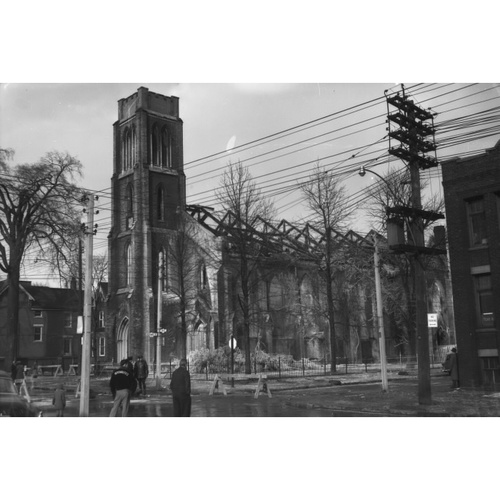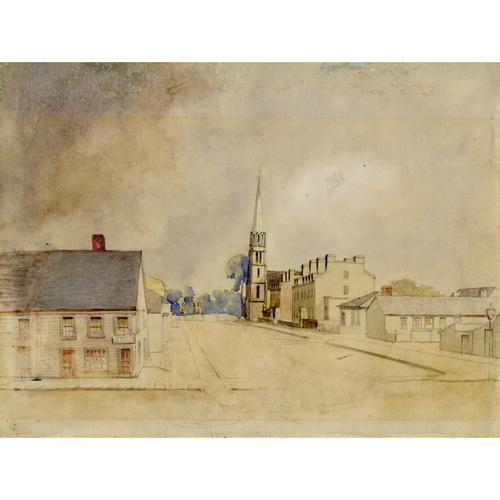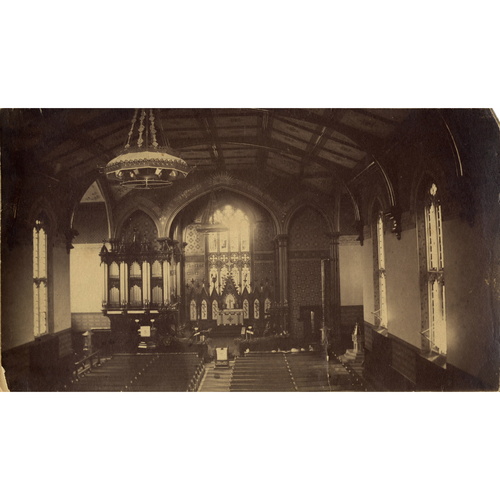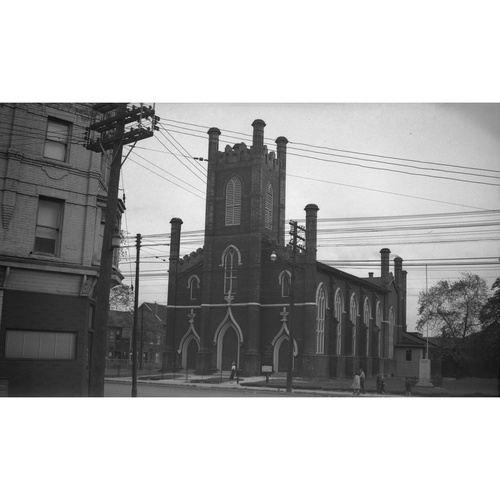LANE, HENRY BOWYER JOSEPH, architect and water-colourist; b. 1817 or 1818 probably on Corfu (Kérkira, Greece), son of Captain Henry Bowyer Lane and Elizabeth Lacey; m. 9 May 1844 Lucy Anne Sharpe in Thornhill, Upper Canada; they had no known children; d. after May 1851, probably in England.
Henry Bowyer Joseph Lane’s father, a Royal Artillery officer and veteran of the Peninsular War, was posted on Corfu between 1815 and 1819. The Lane family was prominent in Staffordshire and in Surrey although Henry spent much of his youth in Devon, where for a brief period in 1830–31 he attended Blundell’s School at Tiverton. The balance of his schooling and his professional training in architecture are presumed to have taken place in England before he emigrated to Canada. He was in this country by 1841, living first in Cobourg, Upper Canada, and then in Toronto.
Although the boom years of the early 1840s saw many new buildings constructed in Cobourg, only two of Lane’s commissions there are known: St Peter’s (Anglican) parochial school (1841), which was also to house the Diocesan Theological Institution [see John Strachan*], and St Peter’s Church (1843). This latter building was completed over a period of several years, all during the rectorship of the Reverend Alexander Neil Bethune*, and in the final phases of the work Lane’s plans were modified by Kivas Tully*, the architect-in-charge.
Lane moved to Toronto in April 1842. There, during the 1840s, a spate of building activity resulted from a general sense that the city’s architecture was no match for its emerging importance. This feeling of architectural poverty was summed up best by the Toronto Star: “We see the stiff, stale appearance of bygone days, vanishing like ugly phantoms and architecture in all its fair proportions, stealing coyly from the dark corner in which it has been confined, either by the niggardliness of propriety or stupidity of the building faculty.” Shortly after Lane’s arrival he prepared plans for Little Trinity Church (Anglican) in the eastern part of the city. He also submitted an entry in the 1843 competition, won by Thomas Young, to design a replacement for the damaged monument to General Sir Isaac Brock* on Queenston Heights. In the following year, however, Lane emerged, at age 26 or 27, as a major figure when his plans were chosen for three significant buildings in Toronto: the market-house and city hall; the Anglican Church of St George the Martyr; and major additions to Osgoode Hall, the home of the Law Society of Upper Canada.
A classical building expressing the importance of common law, Osgoode Hall was clearly Lane’s Canadian masterpiece. He was responsible for the entire west wing, for the impressive stone portico applied to John Ewart’s earlier east wing to create a balanced composition, and for a Palladian loggia and dignifying dome that dressed up an existing range of chambers between the wings. This central section was demolished in 1856, but the new lawcourts and Great Library built in its place to designs by Frederic William Cumberland* and William George Storm* acknowledged Lane’s choice of materials, massing, and style.
The balance of his short career in Canada produced only a few more known commissions of note: ecclesiastical furnishings for St Mark’s Church (Anglican), Niagara (Niagara-on-the-Lake) (1845); plans for St Paul’s Church (Anglican), Kingston (1846), which after a major fire in 1854 was rebuilt under the supervision of William Hay*; Holy Trinity Church (Anglican), Toronto (1846); and houses in that city for Colonel Arthur Carthew and George William Allan*, both begun in 1847. The competition to design Holy Trinity had resulted in the awarding of the premium to William Thomas, a talented designer who had considerably more experience than Lane. Thomas’s plans were set aside, however, and Lane was asked to prepare drawings with advice from a number of architects and others. It is likely that he had a hand in alterations made about that time to Dundurn, the Hamilton mansion of Sir Allan Napier MacNab*. While in Canada, Lane, who as an architect was also a competent artist, made a number of water-colour sketches, chiefly of places he visited. One of these sketches, of the Boulton family’s Toronto home, the Grange, was shown in the 1847 exhibition of the Toronto Society of Arts. In 1845–46 Lane had entered, but did not win, competitions to design several Toronto structures – a new front for the old market buildings, the Commercial Bank of the Midland District, and St Michael’s Cathedral (Roman Catholic) – as well as the combined district court-house, town hall, and market building in Niagara. In each case the first premium went to William Thomas. Lane’s achievements were significant, none the less, and a remarkably large number of his buildings survive as evidence of his skill and his good fortune to arrive in Toronto at an appropriate time.
Lane came to Canada freshly trained in a wide variety of the Gothic Revival and classical styles which were current in England in the late 1830s. He was able, therefore, to inspire confidence that his designs were in fashion, while adapting his choice of architectural style to suit each situation. Little Trinity and Holy Trinity churches were “Domestic-Gothic,” recalling the English parish churches of the Tudor period. On the other hand, the Perpendicular Gothic manner of St George the Martyr, considered the correct style by the emerging ecclesiological societies in England, pleased its well-informed and well-to-do congregation.
Some portion of Lane’s success can be traced to the interest taken in his work by the influential Boulton family, to whom he was related through the marriage alliances of two of his aunts in England. In Cobourg, George Strange Boulton* and his nephew D’Arcy Edward Boulton (who had attended Blundell’s School at the same time as Lane) clearly carried weight, although Lane, who was almost certainly the only professionally trained architect there at the time, would probably have secured some commissions in any event. At Niagara, James Boulton was in a position to be helpful. The Toronto field was more competitive, however, and Lane likely benefited from William Henry Boulton*’s membership on city council and on the building committees of St George the Martyr and Osgoode Hall. After enjoying this powerful patronage for more than six years, Lane left Canada in November 1847 for England and obscurity. In May 1851 he was living in Birchfield (now part of Birmingham) but details of his later life and death are unknown.
[Surviving plans signed by Henry Bowyer Joseph Lane include drawings for the George William Allan house, 1847 (in the J. C. B. and E. C. Horwood coil. (uncatalogued), AO), and the Toronto City Hall (in the Henry Langley papers, nos.172–75, and the J. G. Howard papers, sect.iii, architectural plans, no.415, MTL). Unsigned plans which can be attributed to him include one for Osgoode Hall (in the Horwood coll.), additional studies for City Hall (Howard papers, no.411; Langley papers, nos.170–71) and the Allan house (Howard papers, nos.90–91), and a damaged drawing for the Arthur Carthew house (in the John Fisken papers (uncatalogued), MTL), which is missing that part where a signature might originally have been. There are also three studies for City Hall in Howard’s hand which were probably copied from drawings by Lane (Howard papers, nos.412–14).
Lane’s written specifications for the Allan house, signed and dated 18 Aug. 1847, are also in section iii of the Howard papers (box 2, misc. buildings, 1847–55). He is also the author of an architectural description of the newly completed “Church of the Holy Trinity,” published anonymously in the Church (Toronto) on 15 Oct. 1847 and reprinted on the 19th in the British Colonist (Toronto).
Lane’s sketch The Grange is listed in the Toronto Soc. of Arts catalogue, Toronto Society of Arts: first exhibition, 1847 . . . ([Toronto?, 1847?]), no.155; the water-colour itself is now in the collection of the Art Gallery of Ont. (Toronto). The London Regional Art Gallery (London, Ont.) holds another of his sketches, Quebec, Lower Canada, painted around 1840, this being one of eight Lane water-colours of Canadian subjects and seventeen topographical and architectural sketches of English interest offered at two 1977 auctions in England. The illustration of Osgoode Hall facing page 195 of W. H. Smith, Smith’s Canadian gazetteer; comprising statistical and general information respecting all parts of the upper province, or Canada West . . . (Toronto, 1846), is based on Lane’s sketch; two other contemporary plates depicting his commissions may be seen in C. P. De Volpi, Toronto, a pictorial record: historical prints and illustrations of the city of Toronto, province of Ontario, Canada (Montreal, 1965), plates 13 and 22. s.a.o. and m.b.macr.]
ACC-T, Church of St Peter (Cobourg, Ont.), vestry minute-books, 23 June 1851; Church of the Holy Trinity (Toronto) papers, T. A. Reed, “The Church of the Holy Trinity” (typescript, n.d.), 11, 22; St George the Martyr (Toronto), papers, tenders for construction of church, 1844–45; finances for construction of church, 1842–51, especially W. H. Boulton to H. B. [J.] Lane, 1851, receipted by Lane, 8 May 1851. AO, Map coll., S. A. Fleming, “Plan of the town of Cobourg . . . ,” 1848; MS 35, letter-books, 1844–49: 310; MU 296. Blundell’s School (Tiverton, Eng.), Reg., 1830–31. CTA, RG 1, A, 10 Jan. 1843, 4 March 1844, 30 Jan. 1846; RG 5, F, 1842–47. Law Soc. of U.C. (Toronto), “Journal of proceedings of the Convocation of Benchers of the Law Society of Upper Canada” (8v.), 6, 10 Aug. 1844. MTL, John Fisken papers, papers concerning Arthur Carthew house, 1847–48, especially report, May 1848, [probably by William Robinson] (uncatalogued); J. G. Howard papers, sect.ii, diaries, 15 April, 27 Aug. 1842; 31 July 1844; 29 Jan., 30 Oct. 1847. Univ. of Toronto, Thomas Fisher Rare Books Library, ms coll. 56 (A. N. MacNab papers), L. A. Sharpe to MacNab, 19 Sept. 1849. Sophia MacNab, The diary of Sophia MacNab, ed. C. A. Carter and T. M. Bailey (Hamilton, Ont., 1968), 65–66. “Town Hall and Market House in Niagara,” British Colonist (Toronto), 21 July 1846, reprinted from Niagara Chronicle (Niagara [Niagara-on-the-Lake, Ont.]), 10 July 1846. British Colonist, 20, 27 Aug. 1844; 11 Feb., 27 June 1845; 27, 31 March 1846; 8 June 1847. Church, 21 April, 30 June 1843; 17 May 1844; 21 Nov. 1845; 17 April 1846; 27 Oct. 1847; 22 Feb. 1855. Cobourg Star, 30 June, 7 July 1841; 19 Jan. 1842; 7 June 1843; 24 April, 1 May 1844. Examiner (Toronto), 10 Jan. 1844. Globe, 2 Dec. 1845. Herald (Toronto), 27 July 1843, 11 April 1844, 18 May 1845, 2 July 1846. Toronto Patriot, 2 Feb. 1843, 7 May 1844. Toronto Star, 20 May 1841; 12 April 1842; 13 April, 20 Nov. 1844. John and J. B. Burke, A genealogical and heraldic dictionary of the landed gentry of Great Britain and Ireland (3v., London, 1849), 3: 123. MacRae and Adamson, Cornerstones of order. MacRae et al., Hallowed walls.
Cite This Article
Stephen A. Otto and Marion Bell MacRae, “LANE, HENRY BOWYER JOSEPH,” in Dictionary of Canadian Biography, vol. 8, University of Toronto/Université Laval, 2003–, accessed December 18, 2025, https://www.biographi.ca/en/bio/lane_henry_bowyer_joseph_8E.html.
The citation above shows the format for footnotes and endnotes according to the Chicago manual of style (16th edition). Information to be used in other citation formats:
| Permalink: | https://www.biographi.ca/en/bio/lane_henry_bowyer_joseph_8E.html |
| Author of Article: | Stephen A. Otto and Marion Bell MacRae |
| Title of Article: | LANE, HENRY BOWYER JOSEPH |
| Publication Name: | Dictionary of Canadian Biography, vol. 8 |
| Publisher: | University of Toronto/Université Laval |
| Year of publication: | 1985 |
| Year of revision: | 1985 |
| Access Date: | December 18, 2025 |

























